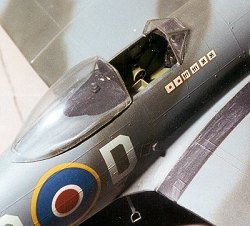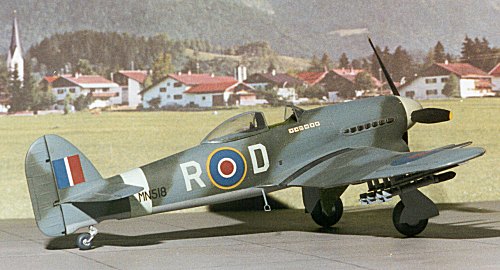
Monogram 1/48 Typhoon IB
Kit Number: 5221
Price: $7.50 MSRP at the time
Media: Injected Plastic
Decals : One aircraft with a blue/white checker tail band

 Comments: The Mongram Typhoon is one of those kits that makes infrequent
appearances on the shelves. It is not because it is a bad kit as that
is far from the truth. I believe it is because it is just not a very glamorous
aircraft. It is also not popular in the U.S. because it
is not American. That is too bad, as this is one of Monogram's better
all around kits. I had no real fit problems with any part of it. It
is a basically simple kit with no moving parts and no fiddly stuff. The
major area of improvement is, of course, the interior. While Monogram
interiors are generally pretty well detailed, the Typhoon interior looked
a little bland. Fortunately there was help in the form of an Airwaves
brass detail set. Almost all the bits are for the interior and include
seat, extra boxes on the sides, rudder pedals and seatbelts. For the
outside, there is a boarding step. The kit really does not need much
else.
Comments: The Mongram Typhoon is one of those kits that makes infrequent
appearances on the shelves. It is not because it is a bad kit as that
is far from the truth. I believe it is because it is just not a very glamorous
aircraft. It is also not popular in the U.S. because it
is not American. That is too bad, as this is one of Monogram's better
all around kits. I had no real fit problems with any part of it. It
is a basically simple kit with no moving parts and no fiddly stuff. The
major area of improvement is, of course, the interior. While Monogram
interiors are generally pretty well detailed, the Typhoon interior looked
a little bland. Fortunately there was help in the form of an Airwaves
brass detail set. Almost all the bits are for the interior and include
seat, extra boxes on the sides, rudder pedals and seatbelts. For the
outside, there is a boarding step. The kit really does not need much
else.
The wheel wells are boxed in and have some detail, the canopy is in two parts so you can show off the newly detailed interior. You have a great set of under wing rockets with launch rails and the gun barrels only need the ends hollowed out. A nice touch is clear parts for the landing lights and the wing tip formation lights (which are a bit undersize).
 What is really needed is a good decal sheet as the Monogram offering
is one of those glossy ones that I am not real fond of. To the rescue came
Arrow Graphics from Canada. They offer a Typhoon sheet for the aircraft
of one of Canada's aces. The sheet comes complete with his kill marks
which include 2 Japanese, two Italian, and two German kill marks. Using
this sheet requires only a minor conversion. His Typhoon was
one of the early IBs so the four-bladed propeller that comes in the kit is
inappropriate and must be changed to a three-bladed unit. While it
seems like an easy task, it does require cutting off three of the four blades
and placing two of the others at the proper angle. Not a simple task,
but it can be done with the help of modeling clay and a circular protractor.
What is really needed is a good decal sheet as the Monogram offering
is one of those glossy ones that I am not real fond of. To the rescue came
Arrow Graphics from Canada. They offer a Typhoon sheet for the aircraft
of one of Canada's aces. The sheet comes complete with his kill marks
which include 2 Japanese, two Italian, and two German kill marks. Using
this sheet requires only a minor conversion. His Typhoon was
one of the early IBs so the four-bladed propeller that comes in the kit is
inappropriate and must be changed to a three-bladed unit. While it
seems like an easy task, it does require cutting off three of the four blades
and placing two of the others at the proper angle. Not a simple task,
but it can be done with the help of modeling clay and a circular protractor.
The finished kit looks very good and is surprising hassle-free and easy to build. It is finished in typical late war British scheme of sea grey/green over light aircraft grey with yellow wing leading edge ID marks and a sky fuselage band and spinner. It is no longer in any of the catalogues, but if you find one, pick it up and give it a try. Recommended for those with some previous experience.
Late note: 21 years of learning new things shows that there are some discrepancies in this one, but it was fun to build and still looks nice.
March 1996
Copyright ModelingMadness.com. All rights reserved.